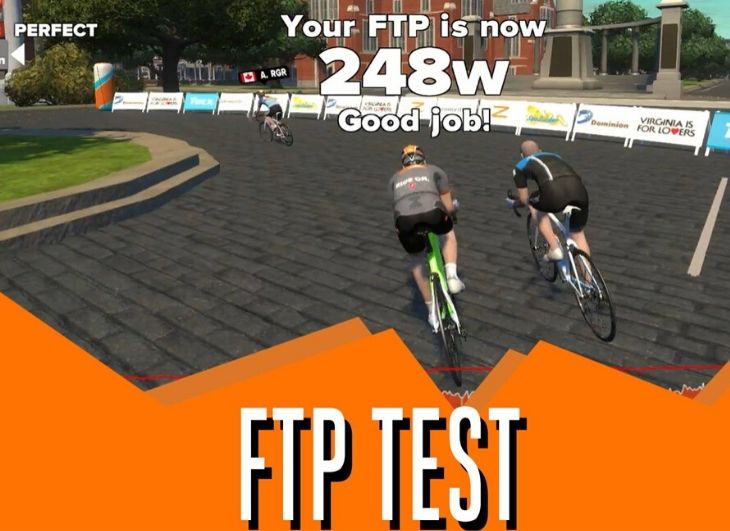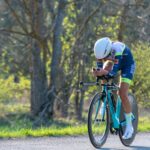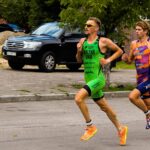As I noted in a previous article, I’m obsessed with triathlon. After an abbreviated 2020 season (I got in three races), I have set some pretty big goals for 2021. A part of my deep commitment to being the fastest I can be this coming season involved installing power meters on both my bikes and hiring a coach to create an individualized training plan to get me in the best shape possible.
Like every other triathlete with similar goals, my training journey began in early December with an FTP test. If you’re not a triathlete, or you are one who doesn’t have internet access, FTP stands for Functional Threshold Power and assesses how much wattage you can maintain for one hour. Its importance is that it establishes power zones that are used to determine volume and intensity of rides you do in my training calendar to make the most gains from your efforts.
My coach, Dr. Greg Rhodes (Ph.D. in Exercise Physiology) scheduled my first FTP test for December 8th which gave me about two weeks to prepare for it physically and mentally. The test including a ten-minute warm-up, 10x30s priming intervals, the 30-minute test itself (the last 20 minutes constituted the FTP interval), followed by a ten-minute cool-down. Simple, right? Wrong!

I initially approached my test date with feelings of apprehension and trepidation. But, given what I do for a living, I decided that I had to practice what I preach, so I began using the many mental tools I teach my clients on myself. Thanks to those efforts, as December 8th neared, I was feeling more motivated, confident, calm, and focused, with only a tinge of nerves about how truly unpleasant my FTP experience might be (totally natural and expected given that it was my first FTP test and the significant physical and mental challenges I would be confronted with.
Tools to Prepare for My FTP
Knowledge is power. Three things that human beings really don’t like is unfamiliarity, unpredictability, and lack of control. This discomfort is wired into us through evolution from when we were knuckle draggers and well before when our reptilian ancestors climbed out of the primordial muck. Back in caveperson times, it helped us survive. It is those three aspects of life that trigger fear in us when we confront any situation, such as an FTP test in 2021, that our primitive brains perceive as threatening to us (even though it won’t kill us).
Thankfully, we humans have developed a part of the brain called the pre-frontal cortex that allows us to think, reason, examine, and understand our world. And it is how we can leverage information into knowledge which gives us the power to overcome our primitive reactions to an FTP test.
So, in the weeks leading up to the FTP test, I continued to read blog posts about the test to learn its why, what, and how, plus the value it is going to provide to my training. I also watched educational and inspirational videos on Youtube, not just the ones that showed a lot of suffering, but to motivate me and gird my determination against the expected pain. The more I learned, the less intimidating the FTP test became and the more excited I was to meet the challenge.

Accept and Embrace the Pain. There’s no denying that an FTP test is going to hurt…A LOT. Not only will trying to deny it not lessen the pain, it will actually cause you to feel more pain because it will be a shock to you when you do your test. Instead I chose to accept what lay ahead as a part of my journey to be the best triathlete I can be. Then, I embraced the pain that I would soon experience because, as odd as it sounds, if it didn’t hurt, I or you wouldn’t do triathlons.
I decided that the pain is my body’s way of inspiring and motivating me and, in the end, would provide me with the feelings of fulfillment and pride in challenging myself, getting out of my comfort zone, and extending my self-imposed limits as an athlete and as a person. When I acknowledged and embraced the pain that would come during my FTP test, I was also preparing myself for that 20-30 minutes of profound discomfort (my coach believes in a 30-minute, not a 20-minute, FTP test). I was getting familiar with the pain and, in doing so, exerting a degree of control over it even before it began.
Mental imagery. Mental imagery is one of the most impactful mental tools that are used by just about every Olympic and professional athlete to maximize their performances (I know this from both professional and personal experience). It was also the most powerful thing I did in the days leading up to my FTP test to better prepare me for the physical and mental challenges it would present to me.
Several times a day, I closed my eyes and saw and felt myself in different phases of the FTP test. I imagined myself settling into a good rhythm at the start of the test, while focusing on staying calm, patient, and steady in my effort. I saw and felt myself in the middle of the test where I was experiencing the growing discomfort of pushing the physical limits. My focus of the imagery was to stay positive and motivated. I also imagined myself during the last five minutes of the test in which I felt myself in great pain and literally talking myself to the end of the test. My focus of the imagery was on seeing the finish line, breathing, and staying determined.
I made my imagery as realistic as I could, experiencing what I would be feeling—pain!—in my upcoming test and successfully overcoming the physical and mental challenges. It was almost as if I was doing an FTP test before I did the actual test, so mentally and emotionally, my upcoming test wouldn’t be my first test. In doing so, I was preparing my mind and priming my body for what lay ahead.
Tools to Succeed at My FTP Test
Using mental tools didn’t stop when my FTP test began. I used them throughout the actual experience enabling me to optimize my test performance.
Visuals. Anyone who has ever tried to push themselves on an indoor trainer knows how difficult it is to stay motivated and focused under normal circumstances much less during a ride as painful as an FTP test. Using Zwift (you may use another virtual cycling platform such as Rouvy, GCT, or Trainer Road) had several mental and performance benefits for me. First, being surrounded by other “riders” got my competitive juices flowing, helping me to stay determined throughout the test. Second, having my power data on my TV screen enabled me to stay on my power target. Third, the “live” surroundings during my ride act as a healthy distraction from the pain I increasingly felt during the duration of the test.
Music. Music is one of the most underappreciated mental tools you can have in your mental toolbox. Music impacts us mentally, emotionally, and physically. It can inspire and excite us as well as make us feel calm and contented.
For my FTP test, I created a playlist of motivating, high-tempo music (think AC/DC, Def Leppard) and blasted it during my test. It had several powerful influences on me. Mentally, the music got me really motivated. Emotionally, I was inspired to give my best effort. And physically, the music got me really fired up, so I had the energy to finish my FTP strong.
Motivational keys. At some point during your FTP test, your body is going to start yelling at your mind to STOP because the pain is becoming increasingly uncomfortable. This reaction is grounded in the evolutionary instinct to survival. Back when we were cavepeople, physical pain sent a message to our primitive brains that our survival was threatened, so we would take steps to reduce our pain, thus increasing our chances of survival. Unfortunately, what worked for our ancestors doesn’t work in our 2021 triathlon lives. Exertion pain is actually a good thing because it means that we are pushing ourselves toward our goals. Yet, our bodies haven’t learned that distinction. If you allow your body to make the decision about whether to continue to push through the pain or ease up to relieve the pain, your body will choose to stop.
To prepare myself for that point when my body was going to begin rebelling against my efforts, I created several motivational keys that I could repeat to myself that would allow my mind to maintain control of my body as the pain grew stronger during the duration of my FTP test. The motivational keys I used were: “Dig Deep,” “Keep Pushing,” and “Finish Strong.” As the volume of my physical pain rose, the volume of my motivational keys also increased. Constantly repeating these motivational keys to myself kept me determined and allowed my body to keep working hard in the face of the growing pain.
Focus, focus, focus. Our bodies are wired to lessen or avoid pain. At a practical level, this tendency means that, whenever our minds lose focus and drift away from the task at hand, that is, continuing to push yourself from start to finish of your FTP test, we are going to slow down. As a result, the ultimate outcome of your FTP test efforts depend on your staying focused throughout. Two of the mental tools I just described helped me maintain my focus. First, I kept my eyes on the power data and timer displayed on TV screen, thus enabling my goal (a maximal effort) and focus to stay front and center in my mind’s eye. This constant awareness of this information prevents your focus from drifting and your effort from decreasing. Second, the motivational keys I just discussed offer you words or phrases
Conclusion
Well, I did survive my first FTP test. Yes, it was really painful, but I also felt inspired by my effort and more motivated than ever to train hard to improve my FTP. It also illuminated ways in which I can push myself in my training. Most importantly, I’m really excited to see what I can do in my next FTP test.
Do you want to take the next step in training your mind to perform your best in training and on race day? Here are four options for you:
- Read my latest mental training book: Train Your Mind for Athletic Success: Mental Preparation to Achieve Your Sports Goals.
- Listen to my Train Your Mind for Athletic Success podcast.
- Take a look at myonline mental training courses.
- Schedule a 1:1 session with me.







